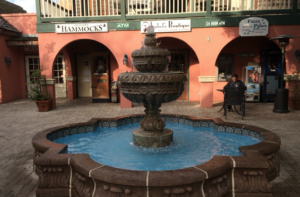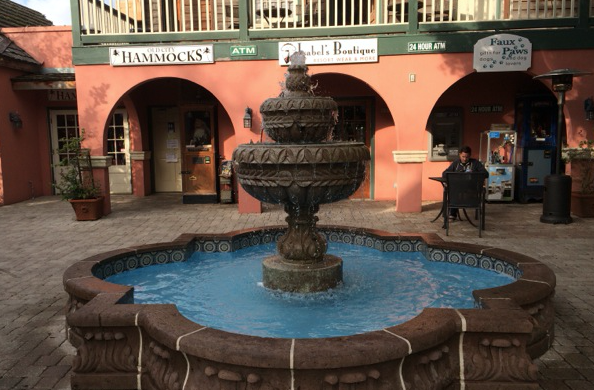 St. Augustine. Visitors to this charming, historic town in north Florida’s Atlantic coast are enchanted by the proximity of water, warmth and America’s past. St. Augustine bills itself as the oldest city in the United States, and people are drawn by this designation. Wherever you look tourists are bustling about, especially in the district known as the Old Town, which conveniently has no-traffic streets and is also a two-minute walk from the ocean.
St. Augustine. Visitors to this charming, historic town in north Florida’s Atlantic coast are enchanted by the proximity of water, warmth and America’s past. St. Augustine bills itself as the oldest city in the United States, and people are drawn by this designation. Wherever you look tourists are bustling about, especially in the district known as the Old Town, which conveniently has no-traffic streets and is also a two-minute walk from the ocean.
Besides strolling through the carless streets and passing restaurants that feature live entertainment at night, some of the popular attractions in the city include a cruise along the St. Augustine waterfront; visits to America’s Oldest Wooden Schoolhouse (1763); the Oldest Store (1900) Museum; the Oldest House; the Old Town hop-on, hop-off trolley that takes you through the city’s sites; Flagler College, with its Tiffany stained glass windows; and the Lightner Museum, housed in the former luxurious Alcazar Hotel, built by railroad magnate Henry Flagler.
Equally old, according to some members of the St. Augustine Jewish Historical Society, is the city’s Jewish community. According to their exploratory research, the first Jews in America came with the founder of St. Augustine, Pedro Menendez de Avilas in September 1565, some 90 years earlier than the traditionally- mentioned date.
This supposition is at odds with the well-established historical fact that America’s first Jews, twenty-three Sephardim from Recife, Brazil, arrived in September 1654, landing in New Amsterdam, later renamed New York. Since Portugal had captured Brazil, these Jews feared the introduction of the Inquisition and decided to flee.
But members of the St. Augustine Jewish Historical Society think that these Jews, very likely Marranos who hid their Judaism because of the Inquisition, portrayed themselves as Catholics. When these first settlers died some were buried with their feet pointing to the church altar; but yet several were buried with feet pointing to the East, to Jerusalem, which was a burial custom of Spanish Jews.
Moreover, the date the people on Menendez’s ship came ashore is puzzling. It happened to be September 8, 1565, which that year was the day after Yom Kippur. Could it be, so think the history buffs of the St. Augustine Jewish Historical Society, that the disembarking was purposely delayed by a day so that Jews, even if their identity was hidden, would not have to violate the holiday? And further, the researchers of the Jewish Historical Society have also found five names of people on Menendez’s ship that matched Jewish family names from Inquisition records.
Still, no major claims are yet being made, for the exploration continues. But the facts gathered so far are doubtless intriguing and fascinating.
Even so, Jews have been in St. Augustine for more than 170 years. In 1845, David Levy Yulee was elected to the United States Senate, the first Jew ever to serve as Senator. Fully organized Jewish community life in St. Augustine came later. Estimations as to the number of Jews now in the city vary between 500-1,000. One long-time Jewish resident in town confessed that the reason for such a disparity between the numbers is that quite a number of Jews in town do not identify as Jews, nor are they affiliated in any way with any of the three local synagogues: one Conservative, one Reform and one Chabad Lubavitch, which is of course Orthodox.
One of the beautiful, historic synagogues in a residential area near the Old Town is the First Congregation Sons of Israel, founded as Orthodox by Russian and East European Jews in 1908 but now a Conservative shul. The sanctuary’s visual appeal is enhanced by century-old stained glass windows. Currently, the synagogue does not have a rabbi.
The Reform synagogue is Temple Bat Yam which, like the Conservative synagogue, has weekly Sabbath services and adult education classes. The Chabad in town has daily services, a school, and adult classes as well.
We stayed right in the heart of the Old Town at the comfortable and welcoming St. George’s Inn, on a pedestrian-only street. This charming hotel has a cluster of wooden buildings with spacious rooms that overlook either a quiet courtyard or have ocean views. A sumptuous breakfast is served as part of the daily hotel rate.
There is no kosher restaurant in town but at 224 W. King Street, about half a mile west of Route 1, there is a vegan restaurant named the Present Moment Cafe. Jews in St. Augustine who seek kosher provisions travel to nearby Jacksonville.
Since few people who drive down South have St. Augustine as their final destination, a few words about the real final stop – Miami Beach – are in order. The splendors and attractions of this world-famous ocean-side city need not be recounted. But a couple of discoveries are in order.
One is the luxurious boutique hotel, The Betsy, at 1440 Ocean Drive, in South Beach, in the heart of the Art Deco district. The Betsy (named after Betsy Ross) has its own swimming pool and is a two-minute walk across a park to the beach where the hotel has its own lounge chairs. A roof deck with chaise recliners has sweeping views of the Atlantic Ocean. The breakfasts are munificent and the Betsy’s BLT Restaurant is considered iconic. What is unique for a Miami Beach hotel, or any traditional resort for that matter, is the year-round arts and culture programming, among them jazz and other musical recitals, a variety of lectures with refreshments, and a Yiddish Salon. All this is no doubt inspired by the fact that Hyam Plutzik, the father of the hotel’s owners, was a noted American poet and professor at the University of Rochester, whose first language was Yiddish.
If you want to eat kosher in Miami Beach, no problem. And for imaginative Chinese cuisine, head for Kikar Tel Aviv, at 5005 Collins Avenue, C-1. In addition to traditional soups like hot and sour, there are meat specialties like boned roast duck, my favorite, and other treats with an oriental flavor. Sabbath observers may pre-pay for Shabbat meals. Intrigued by the menu, I spoke to the Hong Kong-born owner, Bonnie Poon, and asked him how long he has been in Miami Beach. “Ten years,” he said. “And before that I had a restaurant in Tel Aviv for fifteen years.”
Then I continued in Hebrew, saying, “Then you no doubt speak Ivrit.”
“Be-vaday (of course),” he answered at once, and we continued chatting for the next ten minutes in Hebrew.
Only in America; rather; only in Miami Beach.
Curt Leviant’s most recent novels are the critically acclaimed King of Yiddish and Kafka’s Son. His books have appeared in eight languages in Europe and also in Israel and South America.






Comments